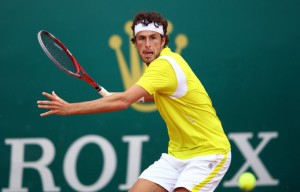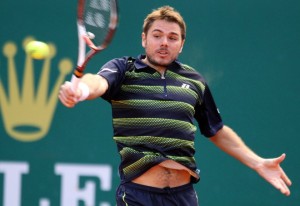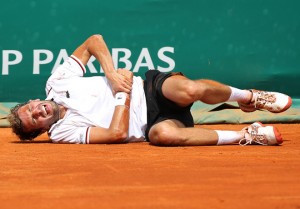Monte Carlo Masters, Third Round
Haase d. Bellucci, 6/2 6/3
Last week in Casablanca, Robin Haase, not the latest great hope of Dutch tennis but still arguably the best, lost to Lamine Ouahab, ranked No.752. It was another low point in a career that too seldom ventures out of the basement. He has now climbed to the quarterfinals of the Monte Carlo Masters, the first time he has risen so high at so august a tournament. Philip Kohlschreiber did not write the book on streakiness (it’s written in French); he is merely its latest custodian.  But there is good reason to think he permits Haase to borrow it from time to time. I picture the Dutchman poring over that oft-handled tome late into the night, studiously absorbing its nuances by furtive torchlight.
But there is good reason to think he permits Haase to borrow it from time to time. I picture the Dutchman poring over that oft-handled tome late into the night, studiously absorbing its nuances by furtive torchlight.
Haase’s form is typically defined by whether his lustily-produced groundstrokes find the court or not. As with, say, James Blake or Andrei Golubev, one assumed he knows no other way to play. Today was thus a surprise. It was decidedly cool in Monte Carlo this afternoon, and damp when it wasn’t flat out sodden. Soggy balls, a tin sky, and mud – it’s difficult to imagine conditions that suit Haase less. They demand patience, thoughtfulness, a willingness to run, and sufficient grunt to impart work onto a leaden ball. (For all that Rafael Nadal professes to prefer a faster, bouncier surface, he certainly has the skills to excel on a day like today, as poor Mikhail Kukushkin discovered). Haase has the grunt, but it was a wonder to see him unleash those other qualities – cerebral and aerobic – in seeing off Tomaz Bellucci.
Bellucci, it must be said, did not read the conditions well, maintaining a quixotic determination to hit through the court until the very end. Nor did he reproduce yesterday’s form, which allowed him to stretcher off a wounded David Ferrer. The result was 40 unforced errors, and several hundred wasted break points. Too often Bellucci would attempt an audacious winner while pushed wide or deep, but Haase was laudable in his commitment to shoving the Brazilian back and across. On a day when only two players truly excelled in bleak conditions, Haase’s sustained focus counts as a minor miracle. He’s back in the top fifty.
Wawrinka d. (8) Almagro, 6/3 6/3
Aside from Nadal, whose victory was so complete that even his hardcore fans must profess themselves satisfied – though some remain concerned his workout lacked sufficient intensity – the most imposing player today was Stan Wawrinka, who trounced Nicolas Almagro. Some had high hopes for Almagro this clay season, based on no clear evidence whatsoever. True, he performed well in South America, but he long ago proved that this hardly heralds success in Europe once the big boys show up.  Some suggested that he would pose the greatest threat to Nadal’s inexorable progress to the final, an assertion based, again, on no evidence whatsoever, except perhaps an uneasy concern that a man who’d lost seven times in a row was due for a win.
Some suggested that he would pose the greatest threat to Nadal’s inexorable progress to the final, an assertion based, again, on no evidence whatsoever, except perhaps an uneasy concern that a man who’d lost seven times in a row was due for a win.
They needn’t have worried. Wawrinka today looked like the more accomplished clay-courter, and while Almagro’s groundstrokes are very impressive, the superior weight the Swiss brings on both the forehand and backhand was obvious, and telling. Almagro looked blunted by the conditions, and Wawrinka did not – his backhand reared off the dull court. Wawrinka was also willing to close on the net, and finish points with touch. The only hiccough came at the end, with a flurry of wasted match points. He had a right to be nervous. He’ll face Nadal in the quarterfinals.
(4) Tsonga d. (13) Verdasco, 7/6 6/2
(6) Berdych d. (12) Nishikori, 2/6 6/2 6/4
Nerves might have explained Fernando Verdasco’s stricken capitulation to Jo-Wilfried Tsonga, if not for the fact that the Spaniard has been in that position so often before, and succumbed in basically the same way every time. He held two set points in the first set tiebreak, and grew timid. On both Tsonga justified his lofty ranking. The second, which the Frenchman took with an audacious dropshot-volley combo, brought down the house. From there he took the set, and soared to a double break in the second. Kei Nishikori and Tomas Berdych breezily split a couple of sets, before getting down to brass tacks in the third.  Nishikori gained a break point at 4/4, constructed a fine point, but took his eye off the ball on the crucial inside-out forehand. Berdych held then broke then started shouting at the sky. Nishikori knew he’d blown it on that forehand.
Nishikori gained a break point at 4/4, constructed a fine point, but took his eye off the ball on the crucial inside-out forehand. Berdych held then broke then started shouting at the sky. Nishikori knew he’d blown it on that forehand.
(9) Simon d. (7) Tipsarevic, 6/0 4/6 6/1
(3) Murray d. Benneteau, 6/5 ret.
Janko Tipsarevic blew it on every stroke, especially in the first set, in which he served at an abysmal 37%, and won only 14% of those that went in. All six games went to deuce, and his opponent, Gilles Simon, won all of them. Both players took a break from this pattern in the second, but reprised it fairly succinctly in the third. We could, I suppose, concede that Tipsarevic isn’t a clay-courter. But nor is Simon. Julien Benneteau played out of his skin for ten games against Andy Murray, but was brought back to corporeality soon enough, crashing heavily to the court several times, and buggering first his ankle, then his elbow. Injury, as ever, proved a sure method of miring a soul threatening to take flight. Murray afterwards suggested there are issues with the courts. Juan Monaco, who is out for a month, doubtless concurs.

One Response to Sodden Balls, A Tin Sky